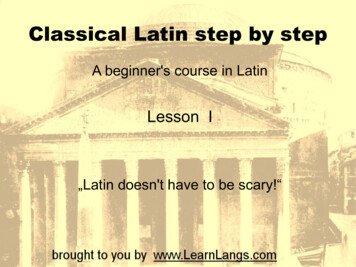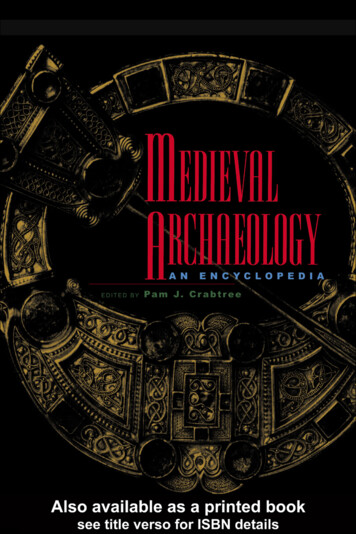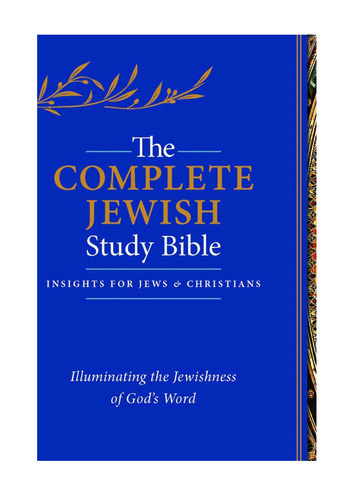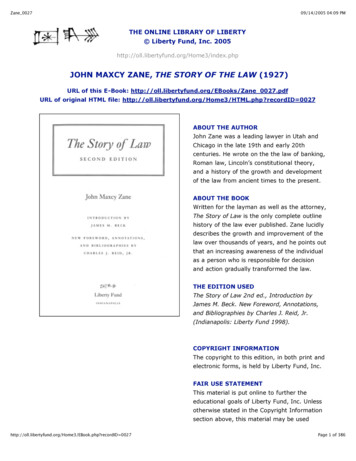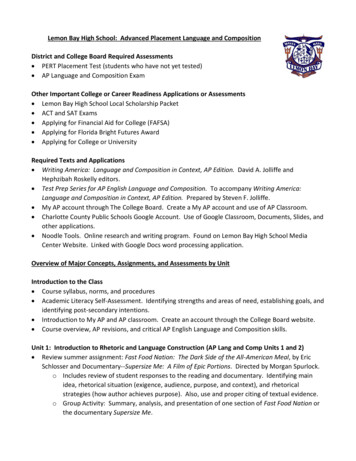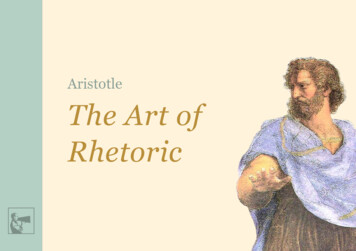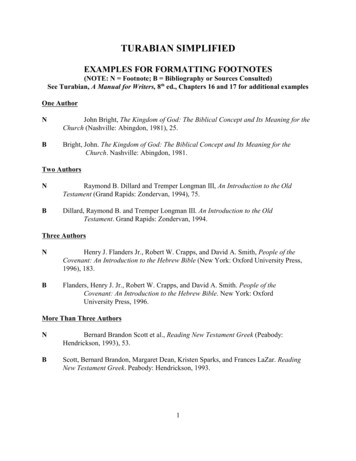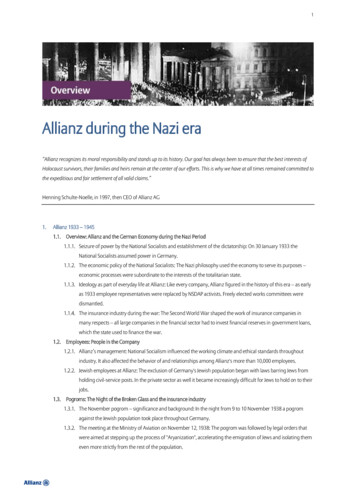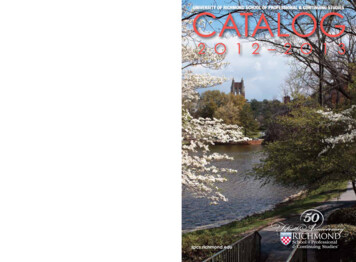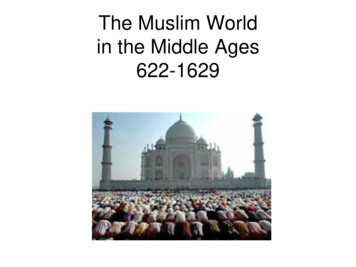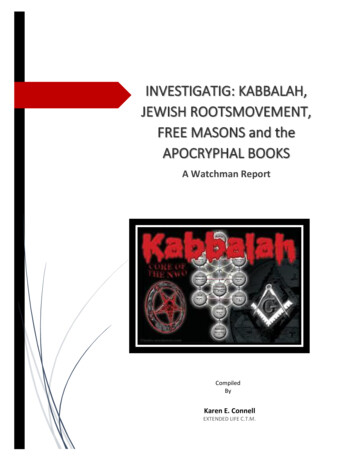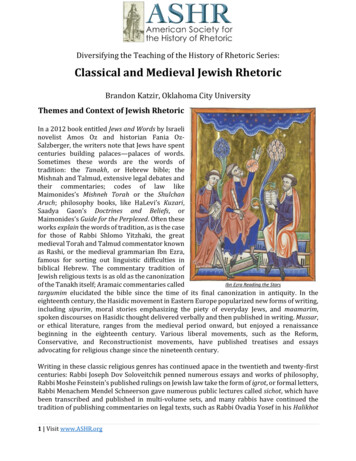
Transcription
Diversifying the Teaching of the History of Rhetoric Series:Classical and Medieval Jewish RhetoricBrandon Katzir, Oklahoma City UniversityThemes and Context of Jewish RhetoricIn a 2012 book entitled Jews and Words by Israelinovelist Amos Oz and historian Fania OzSalzberger, the writers note that Jews have spentcenturies building palaces—palaces of words.Sometimes these words are the words oftradition: the Tanakh, or Hebrew bible; theMishnah and Talmud, extensive legal debates andtheir commentaries; codes of law likeMaimonides’s Mishneh Torah or the ShulchanAruch; philosophy books, like HaLevi’s Kuzari,Saadya Gaon’s Doctrines and Beliefs, orMaimonides’s Guide for the Perplexed. Often theseworks explain the words of tradition, as is the casefor those of Rabbi Shlomo Yitzhaki, the greatmedieval Torah and Talmud commentator knownas Rashi, or the medieval grammarian Ibn Ezra,famous for sorting out linguistic difficulties inbiblical Hebrew. The commentary tradition ofJewish religious texts is as old as the canonizationIbn Ezra Reading the Starsof the Tanakh itself; Aramaic commentaries calledtargumim elucidated the bible since the time of its final canonization in antiquity. In theeighteenth century, the Hasidic movement in Eastern Europe popularized new forms of writing,including sipurim, moral stories emphasizing the piety of everyday Jews, and maamarim,spoken discourses on Hasidic thought delivered verbally and then published in writing. Mussar,or ethical literature, ranges from the medieval period onward, but enjoyed a renaissancebeginning in the eighteenth century. Various liberal movements, such as the Reform,Conservative, and Reconstructionist movements, have published treatises and essaysadvocating for religious change since the nineteenth century.Writing in these classic religious genres has continued apace in the twentieth and twenty-firstcenturies: Rabbi Joseph Dov Soloveitchik penned numerous essays and works of philosophy,Rabbi Moshe Feinstein’s published rulings on Jewish law take the form of igrot, or formal letters,Rabbi Menachem Mendel Schneerson gave numerous public lectures called sichot, which havebeen transcribed and published in multi-volume sets, and many rabbis have continued thetradition of publishing commentaries on legal texts, such as Rabbi Ovadia Yosef in his Halikhot1 Visit www.ASHR.org
Olam or his Anaf Etz Avot, a commentary on the Mishnah tractate Pirkei Avot. And this inventorycovers only religious literature in Hebrew and Aramaic, which, to continue Oz and OzSalzberger’s metaphor, might well represent the main hall of the palace, but is hardly consonantwith the palace itself.It is also the case that Jewish rhetoric—religious or not—can be found in Jewish languages.Yiddish and Ladino (Judeo-Spanish), for example, boast early modern folktales, novels andpoetry, newspapers, and religious instruction. Modern Hebrew, which began proliferating inthe late nineteenth century, developed in isolated circles before becoming the language ofchoice among Jews in Ottoman Palestine and, subsequently, the official language of the State ofIsrael, expanding the canon of Jewish rhetoric to all the genres of rhetoric that exist in any othernational culture. It’s also the case that rhetoric about Judaism or about Jewish communalpolitics or the Jewish community has been a common feature of every Jewish diaspora fromIran to Western Europe to Latin America and the United States in English and German, Arabicand Farsi, French and Spanish, Russian and countless others. Jewish publications talking aboutissues affecting the Jewish community or communities in which Jews live can be found all overthe world and Jews have contributed to the literary cultures of their diaspora communities atleast since the time of Philo.Bibliography for Classical and Medieval Jewish RhetoricBelow, I provide topical bibliographies of primary sources for classical and medieval Jewishrhetoric followed by a list of secondary scholarship on Jewish rhetoric. While these lists arecertainly not exhaustive, they will hopefully provide a foundation for scholars hoping toincorporate Jewish rhetoric in the classroom or in their research.1. Classical Jewish RhetoricBelow are some editions of the Tanakh (the traditional term for the Hebrew bible, based on theacronym TNKh, which indicates the Torah (five books of Moses), the Nevi’im (propheticliterature), and the Ketuvim (writings). In addition to scholarly and religious editions of theTanakh, I have also included scholarly and religious editions of the Mishnah, the first writtencollection of Jewish oral law begun in 300 C.E., and the Babylonian and Jerusalem Talmuds, acommentary on the Mishnah which spans centuries and began at least around 500 C.E. Wherepossible, both academic and religious editions are included. Online editions are included below.Many of these texts are available, with varying degrees of English translation, at Sefaria.org.Biblia Hebraica Stuttgartensia, ed. Karl Elliger and Willhelm Rudulph. German BibleSociety, 1997.JPS Hebrew-English TANAKH. Jewish Publication Society, 2001.Koren Talmud Bavli. Koren, 2012-2019. [42 volumes, English translation andextensive notes by Adin Steinsaltz]2 Visit www.ASHR.org
Koren Talmud Yerushalmi. Koren, n.d. [10 volumes]Koren Tanakh HaMa’alot. Koren Publishers Jerusalem, 2001.The Mishnah: A New Translation, ed. Jacob Neusner. Yale University Press, 1991.Mishnayot Kehati, ed. Pinchas Kehati. Feldheim, 2001. [21 volumes, Englishtranslation available]Philo. Philo: In Ten Volumes, trans. F.H. Colson, George Herbert Whitaker, and RalphMarcus. Harvard University Press, 1991.The Schocken Bible, trans. Everett Fox. Schocken, 2000. [multi-volume]2. Medieval Jewish RhetoricMedieval Jewish rhetoric comprises the writings of philosophers, legalists, and sages from theninth century until the end of the middle ages. Most of the Jewish writing of this period camefrom Jews in Arabic-speaking lands. Especially in the early part of the period, an estimated 90percent of the world’s Jews lived under Islamic rule and spoke Arabic—or Judeo-Arabic—astheir colloquial language. As a result, scholarship abounded in Islamic Neoplatonism, judicialphilosophies, grammar, and poetry.Bahya ibn Paquda. The Book of Direction to the Duties of the Heart, trans. MenachemMansoor. Routledge, 1973.Benjamin of Tudela. The Itinerary of Benjamin of Tudela: Travels in the Middle Ages.NightinGale, 2004.Gluckel of Hameln. The Memoirs of Gluckel of Hameln, ed. Marvin Lowenthal. Schocken,1987.Halevi, Judah. Kuzari: An Argument for the Faith of Israel, trans. H. Slonimsky. Schocken,1964.Ibn Ezra. Sefat Yeter. [Sefaria].Judah Messer Leon. The Book of the Honeycomb’s Flow Sepher Nopheth Suphim, trans.Isaac Rabinowitz. Cornell University Press, 1983.Moses Maimonides (Rambam). Guide of the Perplexed, ed. Shlomo Pines and LeoStrauss. University of Chicago Press, 1974. (2 volumes, English only)3 Visit www.ASHR.org
Moses Maimonides (Rambam). Moreh Nevukim. Feldheim, n.d. (Hebrew only, thisedition contains the original Hebrew of medieval translator ibn Tibbon and alsothe rarely printed work Milot Higayon, Maimonides’s treatise on logic)Saadia Gaon. The Book of Beliefs and Opinions, trans. Samuel Rosenblatt. Yale, 1989.With the exception of the Messer Leon work, all of these texts appear in Hebrew atSepharia.org.3. Secondary Literature on Classical and Medieval Jewish RhetoricBartor, Assnat. Reading Law as Narrative: A Study in the Casuistic Laws of thePentateuch. Ancient Israel and Its Literature. Atlanta: Society of BiblicalLiterature, 2010.Bernard-Donals, Michael. “Between Sublimity and Redemption: Toward a Theory ofHolocaust Representation.” Mosaic: An Interdisciplinary Critical Journal 34, no. 1(March 2001): 61–74.Bernard-Donals, Michael, and Janice Fernheimer, eds. Jewish Rhetorics: History, Theory,Practice. Waltham, MA: Brandeis University Press, 2014.Bernard-Donals, Michael. “Synecdochic Memory at the United States HolocaustMemorial Museum.” College English 74, no. 5 (May 2012): 417–36.Birnbaum, Ruth. “The Role of Reason in Bahya and Maimonides” 19, no. 2 (n.d.): 76–86.Boyarin, Daniel. Intertextuality and the Reading of Midrash. Bloomington: IndianaUniversity Press, 1994.———. Judaism: The Genealogy of a Modern Notion. Rutgers University Press, 2018.———. Socrates and the Fat Rabbis. University of Chicago Press, 2009.———. Sparks of the Logos: Essays in Rabbinic Hermeneutics. Brill, 2003.———. A Travelling Homeland: The Babylonian Talmud as Diaspora. University ofPennsylvania Press, 2015.Boyarin, Jonathan and Daniel Boyarin. Powers of Diaspora: Two Essays on the Relevanceof Jewish Culture. University of Minnesota Press, 2002.Brody, Robert. The Geonim of Babylonia and the Shaping of Medieval Jewish Culture.New Haven, Connecticut: Yale University Press, 1998.4 Visit www.ASHR.org
Charney, Davida. “Performativity and Persuasion in the Hebrew Book of Psalms: ARhetorical Analysis of Psalms 22 and 116.” Rhetoric Society Quarterly 40, no. 3(1974): 175-86.———. Persuading God: Rhetorical Studies of First-Person Psalms. Sheffield PhoenixPress, 2015.———. “Taking a Stance Toward God: Rhetoric in the Book of Psalms.” edited byMichael Bernard-Donals and Janice Fernheimer, 1–15. Waltham, Massachusetts:Brandeis University Press, 2014.Cohen, Shaye. “Judean Legal Tradition and Halakhah of the Mishnah.” In The CambridgeCompanion to the Talmud and Rabbinic Literature, edited by Charlotte ElishevaFonrobert and Martin S. Jaffee, 121–43. Cambridge: Cambridge University Press,2007.David, Joseph E. “Legal Comparability and Cultural Identity: The Case of LegalReasoning in Jewish and Islamic Traditions.” Electronic Journal of ComparativeLaw 14, no. 1 (2010): 1–24.Dolgopolski, Sergey. What is Talmud?: The Art of Disagreement. New York: FordhamUniversity Press, 2009.Edelman, Samuel M. “Ancient Traditions, Modern Needs: An Introduction to JewishRhetoric.” Journal of Communication & Religion 26, no. 2 (2003): 113–25.Einbinder, Susan L. Beautiful Death: Jewish Poetry and Martyrdom in Medieval France.Princeton University Press, 2002.Fernheimer, Janice W. “Black Jewish Identity Conflict: A Divided Universal Audienceand the Impact of Dissociative Disruption.” Rhetoric Society Quarterly 39, no. 1(2009): 46–72.———. “Confronting Kenneth Burke’s Anti-Semitism.” Journal of Communication &Religion 39, no. 2 (Summer 2016): 36–53.———. Stepping into Zion: Hatzaad Harishon, Black Jews, and the Remaking of JewishIdentity. Rhetoric, Culture, and Social Critique. University of Alabama Press,2014.———. “Talmidae Rhetoricae: Drashing Up Models and Methods for Jewish RhetoricalStudies.” College English 72, no. 6 (2010): 577–89.5 Visit www.ASHR.org
Fonrobert, Charlotte Elisheva, and Martin S. Jaffee, eds. The Cambridge Companion toThe Talmud and Rabbinic Literature. Cambridge: Cambridge University Press,2007.Frank, David. “Arguing with God, Talmudic Discourse, and the Jewish Countermodel:Implications for the Study of Argumentation.” Argumentation and Advocacy 41(2004): 71–86.Frank, David A. “The Jewish Question in the New Rhetorics of Kenneth Burke andChaïm Perelman.” Journal of Communication & Religion 39, no. 2 ( 2016): 54–65.———. “A Traumatic Reading of Twentieth-Century Rhetorical Theory: The BelgianHolocaust, Malines, Perelman, and de Man.” Quarterly Journal of Speech 93, no. 3(2007): 308-43.Gitay, Yehoshua. “Biblical Rhetoric: The Art of Religious Dialogue.” Journal for Semitics18 (2009): 34-56.Goitein, S.D. A Mediterranean Society: The Jewish Communities of the Arab World asPortrayed in The Documents of the Cairo Geniza. Berkeley: University ofCalifornia Press, 1978.Greenbaum, Andrea. “Talmudic Rhetoric: Explorations for Writing, Reading, andTeaching.” In Judaic Perspectives in Rhetoric and Composition, edited by AndreaGreenbaum and Deborah Holdstein, 151–69. Cresskill, New Jersey: HamptonPress, 2008.Greenbaum, Andrea and Deborah Holdstein. Judaic Perspectives in Rhetoric andComposition. Hampton Press, 2008.Handelman, Susan A. Fragments of Redemption: Jewish Thought and Literary Theory inBenjamin, Scholem, and Levinas. Indiana University Press, 1991.———. The Slayers of Moses: The Emergence of Rabbinic Interpretation in ModernLiterary Theory. Albany: State University of New York Press, 1982.Hidary, Richard. Dispute for the Sake of Heaven: Legal Pluralism in the Talmud.Providence, Rhode Island: Brown University Press, 2010.———. Rabbis and Classical Rhetoric: Sophistic Education and Oratory in the Talmudand Midrash. Cambridge: Cambridge University Press, 2019.———. “The Rhetoric of Rabbinic Authority: Making the Transition from Priest toSage.” In Jewish Rhetorics: History, Theory, Practice, edited by Michael Bernard6 Visit www.ASHR.org
Donals and Janice Fernheimer, 16–45. Waltham, MA: Brandeis University Press,2014.Holdstein, Deborah H. “The Ironies of Ethos.” JAC 20, (2000): 942-8.Ivry, Alfred. “Jewish Philosophers’ Perceptions of the Nature and Value of Philosophy.”In Wast Ist Philosophie Im Mittelalter, 897–903. Berlin: de Gruyter, 1998.Katz, Claire Elise. “Levinas--Between Philosophy and Rhetoric: The ‘Teaching’ ofLevinas’s Scriptural References.” Philosophy & Rhetoric 38, no. 2 (2005): 159–72.Katz, Steven B. “The Epistemology of the Kabbalah: Toward a Jewish Philosophy ofRhetoric.” Rhetoric Society Quarterly 25 (1995): 107–22.———. “The Ethic of Expediency: Classical Rhetoric, Technology, and the Holocaust.”College English 54 (1992): 255-275.———. “Letter As Essence: The Rhetorical (Im) Pulse Of The Hebrew Alefbet.” Journalof Communication & Religion 26, no. 2 (September 2003): 126–62.Katzir, Brandon. “Against the Philosophers: Writing and Identity in MedievalMediterranean Rhetoric.” Philosophy & Rhetoric 52, no. 4 (2019): 366–83.———. “Paths of Virtue: Legal Rhetorics in Judaism and Islam.” Rhetoric SocietyQuarterly 48, no. 1 (2018): 28–48.———. “‘The Truth of Reliable Tradition’: Saadya Gaon, Arabic Rhetoric, and theChallenge to Rhetorical Historiography.” Rhetorica 35, no. 2 ( 2017): 161–88.Kiewe, Amos. Confronting Anti-Semitism: Seeking an End to Hateful Rhetoric. Kibworth:Troubador, 2011.———. “Theodore Herzl’s The Jewish State: Prophetic Rhetoric in the Service ofPolitical Objectives.” Journal of Communication & Religion 26, no. 2 (2003):208–39.Koban, John E. “‘Guard Your Tongue:’ Lashon Hara and the Rhetoric of Chafetz Chaim.”Journal of Communication & Religion 40, no. 2 (2017): 22–42.Kogan, Barry. “Judah Halevi and His Use of Philosophy in the Kuzari.” edited by DanielH. Frank and Oliver Leaman, 111–35. Cambridge, England: CambridgeUniversity Press, 2003.7 Visit www.ASHR.org
Lesley, Arthur. “A Survey of Medieval Hebrew Rhetoric.” Approaches to Judaism inMedieval Times, edited by Approaches to Judaism in Medieval Times, 107-133.Brown University Press, 1984.Lobel, Diana. A Sufi-Jewish Dialogue: Philosophy and Mysticism in Bahya Ibn Paquda’sDuties of the Heart. Philadelphia: University of Pennsylvania Press, 2007.Marcus, Ivan. Rituals of Childhood: Jewish Acculturation in Medieval Europe. YaleUniversity Press, 1998.McComiskey, Bruce. “Laws, Works, and the End of Days: Rhetorics of Identification,Distinction, and Persuasion in Miqsat Ma’aseh ha-Torah (Dead Sea Scroll4QMMT).” Rhetoric Review 29 (2010): 221-238.Meddeb, Abdelwahab, and Benjamin Stora, eds. A History of Jewish-Muslim Relations:From the Origins to the Present Day. Princeton: Princeton University Press, 2013.Metzger, David. “Maimonides’s Contribution to a Theory of Self-Persuasion.” In JewishRhetorics: History, Theory, Practice, edited by Michael Bernard-Donals andJanice Fernheimer, 112–30. Waltham, Massachusetts: Brandeis UniversityPress, 2014.Metzger, David, and Steven Katz. “The ‘Place’ of Rhetoric in Aggadic Midrash.” CollegeEnglish 72, no. 6 (2010): 638–53.Neusner, Jacob. The Mishnah: Social Perspectives. New York: Brill, 2002.Rabinowitz, Isaac. “Pre-Modern jewish Study of Rhetoric: An IntroductoryBibliography.” Rhetorica: A Journal of the History of Rhetoric 3 (1985): 137-144.Ridolfo, Jim. Digital Samaritans: Rhetorical Delivery and Engagement in DigitalHumanities. Ann Arbor, Michigan: University of Michigan Press, 2015.Rustow, Marina. Heresy and the Politics of Community: The Jews of the FatimidCaliphate. Ithaca, New York: Cornell University Press, 2008.Schumann, Andrew. “Logical Cornerstones of Jewish Argumentation Theory.”Argumentation 27 (2013): 305–26.Shemesh, Aharon. Halakhah in the Making: The Development of Jewish Law fromQumran to the Rabbis. Berkeley: University of California Press, 2009.Wolfson, Harry. Repercussions of the Kalam in Jewish Philosophy. Cambridge,Massachusetts: Harvard University Press, 1979.8 Visit www.ASHR.org
Zaeske, Susan. “Unveiling Esther as a Pragmatic Radical Rhetoric.” Philosophy &Rhetoric 33 (2000): 193-220.Zulick, Margaret. “Prophecy and Providence: The Anxiety over Prophetic Authority.”Journal of Communication and Religion 26 (2003).Brandon Katzir is an Assistant Professor of English at Oklahoma City University. He specializesin medieval Jewish and Islamic rhetorics, as well as in Jewish literature and culture morebroadly. Katzir’s works have appeared in venues like Rhetorica, Rhetoric Society Quarterly, andPhilosophy & Rhetoric.9 Visit www.ASHR.org
Many of these texts are available, with varying degrees of English translation, at Sefaria.org. Biblia Hebraica Stuttgartensia, ed. Karl Elliger and Willhelm Rudulph. German Bible Society, 1997. JPS Hebrew-English TANAKH. Jewish Publication Society, 2001. Koren Talmud Bavli. Koren, 2012-20
